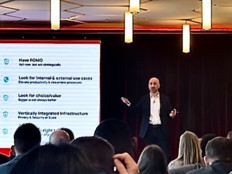Cisco Live 2015: 4 Enablers of the Future Network
The future of networking looks bright: The technology once viewed as only a bunch of hidden routers and switches is now taking the IT spotlight.
Naturally, networking is a principal focus of Cisco Live 2015, being held this week. Rob Soderbery, Cisco's senior vice president of products and solutions, highlighted the fundamental changes occurring in networking and the technologies driving those changes.
“The role of IT is moving from the back office to the front office,” Soderbery said during a Future of the Network session. “From standing up ERP and Oracle databases, and all the cool stuff we’ve been doing in the last 25 years, to the lines of business and how technology can fundamentally change the lines of business.”
But the network itself is not powering the transformation; applications running on the edges of the network — at hospitals, stores, government offices and other touch points — are doing that.
“Those new applications leverage connectivity,” he said. “They leverage the network like never before. To us, the future of the network is applications.”
Every business is thinking about going digital and using the network, he said. To accomplish that, they’ll need to address four main technology areas.

1. Mobility
Mobility is much more than connecting wireless workers in an office. “Mobility is about creating new opportunities in the real-world environment,” Soderbery said.
Cisco’s strategy in this space is anchored by its Connected Mobile Experience (CMX), which Soderbery said has been proven across more than 650 deployments. Cisco views mobility as breaking down into three phases: being able to detect users on the network, connect users to the network and engage with users while they’re on the network.
According to Soderbery, those first two elements are done via CMX, but “the real focus today is now on engagement.”
2. Software-Defined Networking
As organizations continue to build new applications on the edges of the network, they are straining the network tremendously. So what’s the solution? Software-Defined Networking (SDN), or as Cisco calls it, “SD-WAN.”
Jeff Reed, vice president and general manager of software-defined networking and manageability for Cisco’s Enterprise Networking Group, said SD-WAN boils down to three goals.
“How do we deliver more bandwidth for less costs,” he said. “How can we use all the capabilities we have for routing infrastructure to make sure we deliver the best user experience. And as more transactions happen in the network, how do we make sure the data coming back is protected.”
3. Security
As companies become digital entities, security will be a priority for everyone. That's what Cisco product management director Kevin Skahill said just before the company announced its new suite of security products.
“A lot of organizations are facing a new reality where they’re seeing an attack surface that is constantly changing thanks to enterprise mobility and the explosion of mobile devices, as well as the rapid increase of workloads in the data center, thanks to virtualization,” Skahill said. “And that’s just the start. We’re projecting 50 billion new devices coming [onto] the network by 2020.”
At the same time, the attackers are much more sophisticated. “15 years ago, we were facing kiddie hackers,” he said. “They were a major nuisance, but in retrospect, the damage was relatively light. Today, we’re facing organized crime, and they’re running an underground network to the tune of $2 trillion.”

4. Cloud
In the nearly three years since it acquired cloud-provider Meraki, Cisco has been pumping the product group with capital, allowing it to grow global, enterprise-grade abilities.
Todd Nightingale, vice president and general manager at Cisco, said that Meraki can now cater to any cloud need.
“Turns out the biggest companies in the world are really interested in making their networks easy to manage [and] easy to monitor and [in] lowering the cost of their IT systems,” he said. “There are times when cloud management is going to be very powerful and highly distributed. And then there are times you’ll want an on-premises solution. But now you can have both.”








